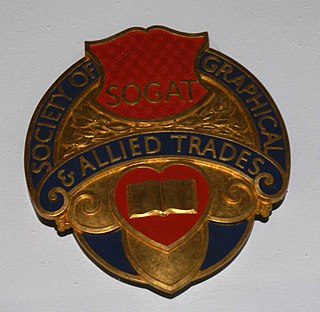Related Research Articles
The Workers' Socialist Federation was a socialist political party in the United Kingdom, led by Sylvia Pankhurst. Under many different names, it gradually broadened its politics from a focus on women's suffrage to eventually become a left communist grouping.

The Society of Graphical and Allied Trades (SOGAT) was a British trade union in the printing industry.

The National Graphical Association (NGA) was a trade union representing typographers and related workers in the United Kingdom.

The Australian Manufacturing Workers Union (AMWU), or more fully the Automotive, Food, Metals, Engineering, Printing and Kindred Industries Union, is an Australian trade union. The AMWU represents a broad range of workers in the manufacturing sector, as well as associated industries, and is affiliated to the Australian Council of Trade Unions.
International Photo-Engravers' Union of North America (IPEU) was a labor union formed in 1904 to represent halftone photoengravers in the printing industry. Its successor union is the International Brotherhood of Teamsters, Change to Win Federation.
The Congress of Irish Unions was a confederation of trade unions in Ireland.
The London Society of Compositors was a British trade union, representing print workers in London.

The National Society of Operative Printers and Assistants (NATSOPA) was a British trade union.
Richard William Briginshaw, Baron Briginshaw was a British trade union leader and politician.

The Federated Ironworkers' Association of Australia (FIA) was an Australian trade union which existed between 1911 and 1991. It represented labourers and semi-skilled workers employed in the steel industry and ironworking, and later also the chemical industry.
The General Council of the Trades Union Congress is an elected body which is responsible for carrying out the policies agreed at the annual British Trade Union Congresses (TUC).

The Printing and Kindred Trades Federation (P&KTF) was a trade union federation in the United Kingdom.
The Irish Graphical Society was a trade union representing workers in the printing trades in Dublin.
The National Amalgamated Society of Printers' Warehousemen and Cutters was a trade union in the United Kingdom.
The Irish Bookbinders' and Allied Trades Union was a trade union representing print workers in Ireland.
Owen O'Brien was a British trade union leader.
The United Society of Engravers was a trade union representing engravers, principally in the cotton industry, but also in the paper printing industry, in the United Kingdom.
Thomas James Smith was a British trade union leader.
The Bookbinders and Machine Rulers' Consolidated Union (B&MRCU) was a trade union representing people involved in the manufacturing of books in the United Kingdom.
Walter Clark Warren was a British trade union leader.
References
- 1 2 3 Marsh, Arthur; Smethurst, John B. (2006). Historical Directory of Trade Unions. 5. Aldershot: Ashgate Publishing. pp. 52, 72. ISBN 085967990X.
- 1 2 "National Society of Electrotypers and Stereotypers, London Branch". Modern Records Centre. University of Warwick. Retrieved 4 March 2019.